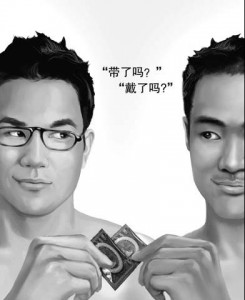From sex toys to growing acceptance of gays, China’s sexual culture is becoming more liberal and diverse
The rapidly changing sexual culture of the People’s Republic of China (PRC) over the last three decades is emblematic of the country’s ongoing economic and cultural revolutions and yet inseparable from its history.
When we wrote our book, Sex in China, we did not realise we were opening a Pandora’s Box—such are the number of topics to discuss and issues to cover relating to sex in China today.
Journalists often suggest that China’s more visible sexual culture indicates that the PRC is in the midst of a western-style sexual revolution. Take the sex toy industry as an example. China manufactures the 70 per cent of the world’s sex toys, worth billions of dollars to the Chinese economy. While 10 years ago such goods were only for export and rarely seen in China, they are now available everywhere in the country. Sex toys are also traded online, and feature in the China Adult-Care Expo, the biggest sex expo in Asia and one of top three expos for sex toys in the world.
Sex and sexuality are now used by young Chinese adults, in particular, as a rebellion against tradition and authority, a marker for self-identity, a declaration of self-value, and a commodity for personal gains. Casual sex is popular, especially among disco-and nightclubgoers, and some even bring their sexual (ad)venture online to reap tangible and intangible benefit from their ‘fame’. However, the story is more complicated than the narrative of sexual revolution allows.
Sex education
While Chinese sexual culture has become more liberal and diversified, it depends on which age group, class, region, religion and ethnicity one speaks of. Sex education is badly needed and poorly managed. More than one study has found that more than 70 per cent of Chinese young people have sex before marriage, with more partners, at a younger age. Yet sex remains a sensitive topic among parents and teachers. A lack of sex education means that many sexually active people are not protecting themselves, resulting in soaring abortion rates among teenage girls and a rise in sexually transmissible infections more generally.
Casual sex is more tolerated among urban and cosmopolitan Chinese than, say, people from second- and third-tiered cities and villages. But with the flux of rural-to-urban migration—one of the factors in Arjun Appadurai’s five scapes that contribute to the global exchange of ideas and information—even the ‘country bumpkins’ are involved in various kinds of sex trade. Female prostitutes and money boys are found among migrant workers, college students and urban poor. The ‘sex and the city’ syndrome has swamped the whole nation, with the rich and powerful at the top of the social hierarchy and the poor and vulnerable at the bottom when it comes to sexual exploitation.
China’s sexual revolution is gendered, classed and structurally imbalanced. China’s ‘one child per couple’ policy has resulted in millions more men than women—an estimated 30 million more men than women by 2020. Those at the bottom of the pyramid in the marital market—the redundant males, or ‘bare branches’—will not be able to find a wife or have a family, due to the asymmetrical marriage squeeze: lack of women and women marrying up.

As a result, we’ve seen the booming of the commercial sex industry to service these hordes of single men in what has become the world’s fastest growing sex trade. Sexual transmission has become the main route for the spread of HIV in China, and sex trade and violence against girls and women whose agency is limited under China’s millennial-long patriarchal value system are increasing.
The new two-child policy may ease the problem of China’s gender imbalance and aging society, but it will have negative impact on women in employment and status within the family. Childbirth and carer responsibility mean that many women have more limited opportunities for career advancement and often suffer financially. Employers are not penalised for refusing to employ women of childbearing age (to avoid potential maternity leave), or women with two young children (to avoid personal leave). Despite the rise of rights consciousness and human rights movements championed by courageous social activists, many women are reluctant to be or be called a feminist because the term feminism is stigmatised in China.
The majority of Chinese have just started to accept that homosexuality exists in their society and culture—it was a hard fact to accept even 10 years ago. But they talk about homosexuality in a similar way as they talk about AIDS: it is ‘other people’s problem’, a distanced and unfortunate twist of life.
Many Chinese gays and lesbians continue to live a double life–straight during the day and gay at night. Or they are forced to suppress their homosexuality and be like ‘everybody else’: get married and have kids to carry on the family line. Hence all sorts of phenomena and associated problems emerge, such as ‘homowives’ (wives of homosexual men) and pro forma or fake marriages between a gay man and a lesbian.
However, such attitudes can change rapidly—as we have seen in many western societies where, in a relatively short period, community acceptance of gay and lesbian lifestyles and relationships has grown significantly.
For better or worse, sex—in all its manifestations— is now a visible, celebrated and complicated feature of public life in China.
Haiqing Yu is Senior Lecturer of Chinese media and culture at UNSW. Elaine Jeffreys is an Australian Research Council Future Fellow and Associate Professor in China Studies at the University of Technology Sydney.
Main photo:
A Chinese sex shop. Frank Yu, Flickr. CC BY-SA 2.0

